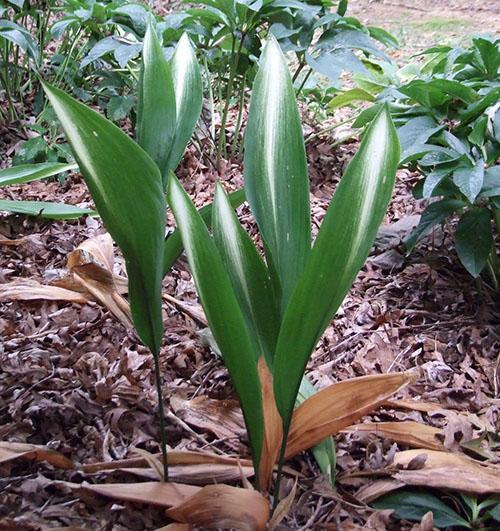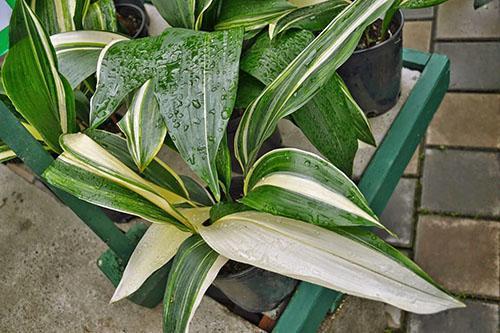What is the problem with aspidistra?
 Aspidistra, which became fashionable about a century ago, have gained a reputation among fans of home floriculture as almost eternal plants. This culture is not afraid of thick shade, temperature drops and a long absence of watering.
Aspidistra, which became fashionable about a century ago, have gained a reputation among fans of home floriculture as almost eternal plants. This culture is not afraid of thick shade, temperature drops and a long absence of watering.
The erect leaves of aspidistra are distinguished by the highest vitality. The plant, which in nature forms dense clumps under the canopy of a tropical forest, grows just as well at home. Today, more and more often in areas where the air does not cool below –5 ° C in winter, aspidistra feels good outdoors, becoming a bright green decoration of the garden, edging paths and the local area.
At home, aspidistra is considered a slow growing pot culture. The plant forms a branched powerful rhizome, from which additional nourishing roots extend, leaves and small greenish or purple flowers grow, located at the ground level. Depending on the variety and species, aspidistra leaves grow to a height of 25–60 cm, and adult plants can form clumps up to half a meter in diameter. Therefore, when growing such a crop in the house, it is better to take pots with a diameter of 15 to 25 cm.
Otherwise, plant care can really be called minimal. The plant easily tolerates exposure to cold and dry air, keeping in the shade, drought and excess watering... Even cut greens remain fresh for up to several weeks.

Most often, the deterioration in the appearance of the plant becomes a response to lack of care and inappropriate conditions of detention.
Without leaving, aspidistra turns yellow and dries
 Aspidistra prefers to live in partial shade or shade, but, like other representatives of the green world, reacts poorly to dry air. Improper growing conditions lead to the leaves of aspidistra first turning yellow at the tips and then drying. If the plant is located near the streams of hot air from heating devices, the situation is aggravated.
Aspidistra prefers to live in partial shade or shade, but, like other representatives of the green world, reacts poorly to dry air. Improper growing conditions lead to the leaves of aspidistra first turning yellow at the tips and then drying. If the plant is located near the streams of hot air from heating devices, the situation is aggravated.
The situation can be corrected by moving the pot further from the heater and providing an acceptable air humidity for the aspidistra.
Florists who take plants into the garden in the summer may be faced with the fact that as a result of night frosts, the tips of the leaves are damaged. If you do not take any measures, transient necrosis affects all new areas of the aerial part. The leaves turn brown and dry along the veins. And due to the arcuate venation of the aspidistra leaf, the leaf plates split and lose functionality. The hot summer sun affects the foliage just as destructively if the aspidistra is in an area open to the rays.
Features of watering and feeding aspidistra
 Aspidistra are not too sensitive to irrigation disturbances, but the abuse of such unpretentiousness of the plant is not endless. At one "fine" moment the leaves of the aspidistra turn yellow and dry.
Aspidistra are not too sensitive to irrigation disturbances, but the abuse of such unpretentiousness of the plant is not endless. At one "fine" moment the leaves of the aspidistra turn yellow and dry.
And the plant signals about chronic waterlogging of the soil by browning and wilting of the tips and edges of the leaf plates. It is enough to set up watering to stop the growth of the disease of aspidistra.And so that in the future the green pet does not feel discomfort, it is necessary to water the flower when the substrate in the pot dries out 3-4 cm in depth.
If aspidistra does not grow, there is no new foliage for a long time, and the old one has lost its luster and elasticity, it is likely that the flower is suffering from a lack of nutrition.
 During the period of active growth, aspidistru, following the recommendations on the selected fertilizer, is fed at least once a month. It is best if the plant receives complex products for decorative deciduous crops. Moreover, the owner should take into account that nitrogen forces the plant to form a green mass. But the excess of the element negatively affects the quality of the leaves, which become brown and dry.
During the period of active growth, aspidistru, following the recommendations on the selected fertilizer, is fed at least once a month. It is best if the plant receives complex products for decorative deciduous crops. Moreover, the owner should take into account that nitrogen forces the plant to form a green mass. But the excess of the element negatively affects the quality of the leaves, which become brown and dry.
A flower grower who is interested in why aspidistra does not bloom, you can try to feed the plant with potassium and phosphorus... Perhaps such support, together with loosening the soil surface, will help the aspidistra to form and open buds.
The cause of aspidistra disease is water
 Surprisingly, regular tap water can cause aspidistra disease. The fact is that in some areas, the water flowing from the tap contains many minerals and salts. Their excess easily harms green plants, which, like aspidistra, try to remove moisture with salts dissolved in it through leaf plates.
Surprisingly, regular tap water can cause aspidistra disease. The fact is that in some areas, the water flowing from the tap contains many minerals and salts. Their excess easily harms green plants, which, like aspidistra, try to remove moisture with salts dissolved in it through leaf plates.
When water evaporates, salts and minerals accumulate in the leaf tissues and cause chemical burns and stunted growth. Therefore, watering and spraying aspidistra is necessary with soft, settled or filtered water.
Why is aspidistra not growing?
 Sometimes adult aspidistra stop growing, although they are regularly watered and kept in the conditions necessary for the plant. Why doesn't aspidistra give new leaves?
Sometimes adult aspidistra stop growing, although they are regularly watered and kept in the conditions necessary for the plant. Why doesn't aspidistra give new leaves?
The reason is to look inside the pot. Most often, the plant has completely exhausted the possibilities of the soil, and the rhizome has occupied the entire volume of the pot. Therefore, the pet does not develop. In this case, it is best to transfer the aspidistra into a new, larger pot, or divide the earthen lump into several parts, from which, after transplanting, several independent bushes will form.
In order not to face a situation where a healthy aspidistra does not bloom, the rhizome should not be buried when transplanting plants. Otherwise, the buds simply will not be enough for a short, in some species, a petiole that grows only a couple of millimeters to overcome the substrate layer.
What other problems can arise at home, and how to determine what aspidistra is ill with?
Diseases of aspidistra
 If the rules of care and maintenance are not followed, the plants are exposed to root rot and leaf spot.
If the rules of care and maintenance are not followed, the plants are exposed to root rot and leaf spot.
Anthracnose is a common fungal disease of aspidistra, manifested in the fact that the leaves of the culture turn yellow, then gradually turn brown and die off. If the plant has yellow rounded spots on the leaf plates with an expanding circle of dry tissue in the center, then you should not hesitate.
All affected leaves of aspidistra are cut off, spraying of the aerial part is stopped, since the fungus actively spreads through drops of water and can spread to healthy leaves and neighboring plants. If the problem persists, the plant is transplanted into fresh soil and treated with a fungicide.
 Fusarium on aspidistra leaves is characterized by the formation of foci of decay at the base of the petiole. But the dying off of foliage is only an external manifestation. The rhizomes of the plant rot and turn black.
Fusarium on aspidistra leaves is characterized by the formation of foci of decay at the base of the petiole. But the dying off of foliage is only an external manifestation. The rhizomes of the plant rot and turn black.
To help the sick aspidistra, they improve drainage, cut off all affected areas of the roots and crowns, change the irrigation schedule and select fresh, loose soil. It is useful to treat the plant with a copper-based fungicide. The procedures are carried out once a week until all signs of the disease disappear.
 The best defense against fungal diseases is prevention, which consists in proper care and constant attention to the condition of the leaves of the aspidistra and the entire plant as a whole. Indeed, most often fungal diseases develop with excessive or irregular watering, which weakens the pot culture. Healthy plants do not cause trouble, but long and willingly grow, bloom and delight the owners.
The best defense against fungal diseases is prevention, which consists in proper care and constant attention to the condition of the leaves of the aspidistra and the entire plant as a whole. Indeed, most often fungal diseases develop with excessive or irregular watering, which weakens the pot culture. Healthy plants do not cause trouble, but long and willingly grow, bloom and delight the owners.